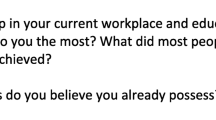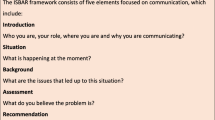Abstract
For a doctor to provide medical care with competence, he must not only have knowledge but must also be able to translate that knowledge into action. It is his competence in clinical skills that will enable him to practice safely and effectively in the real world. To ensure acquisition of clinical skills, medical teachers must adopt teaching methods that prioritise observation, practice, feedback; and more practice. We try to elucidate the meaning of clinical skills, the challenges inherent in clinical skills training in India, training models that have shown success in practice and can be adopted in the Indian context, and various techniques to enhance skill-training, including the giving of feedback, which is a critically important component of skills development.
Similar content being viewed by others
References
Miller GE. The assessment of clinical skills/competence/performance. Acad Med. 1990;65:S63–7.
Benbassat J, Baumal R, Heyman SN, Brezis M. Suggestions for a shift in teaching clinical skills to medical students: the reflective clinical examination. Acad Med. 2005;80:1121–6.
Dave R. Developing and Writing Behavioural Objectives. In: Armstrong R, editor. A Systematic Approach to Developing and Writing Behavioral Objectives. Tucson, Arizona: Educational Innovators Press, Inc.; 1968.
Byrne AJ, Pugsley L, Hashem MA. Review of comparative studies of clinical skills training. Med Teach. 2008; 30:764–7.
Medical Council of India. Vision 2015. Available from: http://www.mciindia.org/tools/announcement/MCI_ booklet.pdf. Accessed June 1, 2016.
Association of American Medical Colleges. Recommendations for Clinical Skills Curricula for Undergraduate Medical Education. Available from: https://members.aamc.org/eweb/upload/Recommendations for Clinical Skills Curricula 2005.pdf. Accessed June 1, 2016.
Accreditation Council for Graduate Medical Education. ACGME Common Program Requirements. Available from: http://www.acgme.org/Portals/0/PFAssets/Program Requirements/CPRs_07012015.pdf. Accessed June 1, 2016.
Flower J. In the mush. Physician Exec. 1999;25:64–6.
Dreyfus SE. The five-stage model of adult skill acquisition. Bull Sci Technol Soc. 2004;24:177–81.
Benner P. From Novice to Expert: Excellence and Power in Clinical Nursing Practice. Commemorat. New Jersey: Prentice Hall; 2000. Available from: http://www.amazon.in/From-Novice-Expert-Excellence-Commemorative/dp/0130325228. Accessed June 1, 2016.
Singh T, Modi JN. Workplace based assessment: a step to promote competency based postgraduate training. Indian Pediatr. 2013;50:553–9.
Ramani S, Leinster S. AMEE Guide no. 34: teaching in the clinical environment. Med Teach. 2008;30:347–64.
Solanki A, Kashyap S. Medical education in India: current challenges and the way forward. Med Teach. 2014;36:1027–31.
Picarella EA, Simmons JD, Borman KR, Replogle WH, Mitchell ME. “Do one, teach one” the new paradigm in general surgery residency training. J Surg Educ. 2011;68:126–9.
Krautter M, Weyrich P, Schultz JH, Buss SJ, Maatouk I, Jünger J, et al. Effects of Peyton’s four-step approach on objective performance measures in technical skills training: a controlled trial. Teach Learn Med. 2011;23:244–50.
Lake FR, Hamdorf JM. Teaching on the run tips 5: teaching a skill. Med J Aust. 2004;181:327–8.
Nikendei C, Huber J, Stiepak J, Huhn D, Lauter J, Herzog W, et al. Modification of Peyton’s four-step approach for small group teaching–a descriptive study. BMC Med Educ. 2014;14:68.
Reilly BM. Inconvenient truths about effective clinical teaching. Lancet. 2007;370:705–11.
Ricciotti HA, Dodge LE, Head J, Atkins KM, Hacker MR. A novel resident-as-teacher training program to improve and evaluate obstetrics and gynecology resident teaching skills. Med Teach. 2012;34:e52–7.
Tolsgaard MG, Gustafsson A, Rasmussen MB, Høiby P, Müller CG, Ringsted C. Student teachers can be as good as associate professors in teaching clinical skills. Med Teach. 2007;29:553–7.
Montacute T, Chan Teng V, Chen Yu G, Schillinger E, Lin S. Qualities of resident teachers valued by medical students. Fam Med. 2016;48:381–4.
Haraldseid C, Friberg F, Aase K. Nursing students’ perceptions of factors influencing their learning environment in a clinical skills laboratory: A qualitative study. Nurse Educ Today. 2015;35:e1–6.
Cleland JA, Abe K, Rethans J-J. The use of simulated patients in medical education: AMEE Guide No 42. Med Teach. 2009;31:477–86.
Kalaniti K, Campbell DM. Simulation-based medical education: time for a pedagogical shift. Indian Pediatr. 2015;52:41–5.
Beigzadeh A, Bahmanbijari B, Sharifpoor E, Rahimi M. Standardized patients versus simulated patients in medical education: are they the same or different. J Emerg Pract Trauma. 2016;2:25–8.
Singh T, Sood R. Workplace-based assessment: measuring and shaping clinical learning. Natl Med J India. 2013;26:42–6.
Singh T, Kundra S, Gupta P. Direct observation and focused feedback for clinical skills training. Indian Pediatr. 2014;51:713–7.
Kundra S, Singh T. Feasibility and acceptability of direct observation of procedural skills to improve procedural skills. Indian Pediatr. 2014;51:59–60.
Hesketh EA, Laidlaw JM. Developing the teaching instinct, 1: feedback. Med Teach. 2002;24:245–8.
Author information
Authors and Affiliations
Corresponding author
Rights and permissions
About this article
Cite this article
Dhaliwal, U., Supe, A., Gupta, P. et al. Producing competent doctors — The art and science of teaching clinical skills. Indian Pediatr 54, 403–409 (2017). https://doi.org/10.1007/s13312-017-1114-2
Published:
Issue Date:
DOI: https://doi.org/10.1007/s13312-017-1114-2




